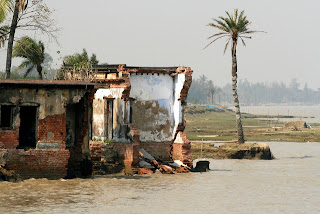The Rainbow Warrior sailed on past the east coast and docked yesterday at the Chennai port. There was also an amazing action last morning where the climate action team painted the message 'Cut Coal Save Climate' on the hull of a cargo ship (the INS Sridevi) laden with coal. India right now, (actually based on 2002 data) stands at fifth place on the list of the world's largest polluters. The current development plans envisage an addition of 73 new coal fired power plants. By themselves, these coal megaliths will raise India to the third position. Greenpeace and Solar Generation are strongly against this kind of blind development plans. We need clean power if we want to stick around long enough to see India as a world leader, in whatever field it is.
In the last post I mentioned how officials sent to survey the population of the Sunderbans were shocked to discover that an entire island had disappeared beneath the sea. A Kolkata based scientist, along with his team of oceanographers at the Jadavpur University have identified another island that submerged at about the same time, although there is no record of any human settlement on that island.
Around the same period, a series of cyclones and droughts battered the coastal state of Orissa. Although the Orissa droughts and Super-cyclone made it to media prime-time, little corrective actions can be said to have taken place. As of today this state continues to suffer from the effects of climate change. An already poor people (Orissa scores a meagre 1 - 1.5 on a scale of 5 in the economic development indices), the Oriyas today are struggling to sustain their lives. Orissa has to its credit several dubious distinctions, including supposed trafficking in women, highest numbers of infant mortality due to malnourishment and record numbers of migration due to rising sea levels eating into the coast.
If truly there are climate change hotspots in India, Orissa figures at the top of the list. Greenpeace and Solar Generation India have separately documented the effects of climate change already being experienced by the Oriyas.
Given below is the first video created, directed and shot entirely by the team of Solar Generation. Take a look:
One is forced to feel ashamed about the clueless leadership that seems to prevail in our country after one witnesses the suffering that these people seem to have accepted as part of their lives.
I didn't want to drag this post on for too much longer but couldn't help but share this story.
The region over which Orissa stands now is roughly the extent over which a medieval Indian kingdom, that of the Kalingas, once stood. The Emperor Ashoka waged a lengthy and bloody war on the Kalingas and defeated them. At the end of this war, the king who was known as Chandashoka, "the cruel Ashoka," was so moved by the suffering he had imposed on the Kalingas that he gave up all violence and adopted Buddhism, giving up his traditional Vedic religious beliefs. Later, Emperor Ashoka was rechristened, from "the cruel Ashoka" (Chandashoka) to "the pious Ashoka" (Dharmashoka).
I wonder if the descendants of the Kalingas will once again be forced to embrace oblivion in the face of senseless greed.



